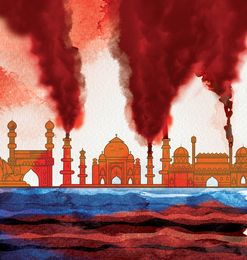R.K. Laxman once drew a cartoon showing the Common Man perched on the roof of a flooded building which bore the signboad ‘Drought Relief Centre’, and a chaprasi, who had arrived in a country boat, giving him another one to replace it. The new board read: ‘Flood Relief Centre’.
India’s cities are trapped in the same binary—between the heat of hell and the hell of high water. Look at Delhi. The city is thirsting for water currently, with taps having gone dry and temperatures soaring to Sahara levels. In two or three weeks, Delhizens—that includes me—will complain of floods in some parts and of waterlogging on most streets. It takes only days for the city and its citizenry to switch from groaning about no water to wailing about excess water.
No different are most other cities. The streets of Bengaluru were flooded during the rains last year; this summer the city has been thirsting for water.
Who are to blame? In the case of Delhi, it is four sets of people.
The first set are our usual suspects, the politicians. Delhi, ruled by the Aam Aadmi Party, gets 40 per cent of its water from the Yamuna in the BJP-ruled Haryana, 25 per cent from the Ganga in Uttar Pradesh which is also ruled by the BJP, and 22 per cent from the Bhakra Nangal on the Sutlej in Congress-ruled Himachal. The remaining 13 per cent has to come from Delhi’s own innards, its deep underground, through tubewells and ranney wells.
Delhi’s Aam Aadmi rulers—the jailed ones, the fasting ones and the few free ones—say Haryana is of no help. Neither is it giving water, nor allowing water from the fairly friendly Himachal to flow through Haryana into Delhi. In short, there is many a slip and several barrages between the reservoir up the Sutlej and the dry tap down in Delhi.
The second set are our inept engineers. They haven’t desilted the river and the water reservoirs in time. If they had, the reservoirs wouldn’t have flooded out during the monsoon, and would have had that water for us to drink in summer.
The third are our myopic town planners and greedy real estate developers. Look at the ‘ground reality’. Bengaluru, which had more than 1,400 water bodies in the 19th century, has only 193 today. A Jal Shakti ministry report of last year said that three out of four of Delhi’s 893 ponds and lakes had dried up, built over, become sewage pools or filled with solid waste. Huge acreages that once sported a bungalow or two have been turned into square miles of solid concrete and floor tiles that don’t allow even a drop of water to percolate. Every possible square inch of the ground—courtyards, parking spaces, park walkways and all—has been cemented or tiled up.
The result? All the water that Indra showers on Indraprastha simply floods the surface, and goes down the drain literally, or into the few rain water harvesters which are nothing but cosmetic attachments to buildings. With the result, Mother Earth under Delhi’s 1,488 square kilometres is as dry as baked brick. There is no sub-surface water for tubewells to pump up. A Central Groundwater Board report of last year said that 41 per cent of subterranean Delhi has been sucked dry.
Now for the fourth culprits. Ladies and gentlemen, look into the mirror. We, the pampered citizens of Delhi, are the fourth cause for both the current tap drought, and next month’s waterlogging. We tile up our building premises, letting the water flow into the streets. And studies say, a third of us keep the tap on while brushing, shaving and bathing.
Let’s mend our ways before blaming others.


